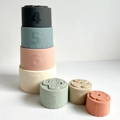Stacking, Sorting, & Matching for Toddlers: Why Do They Find It So Fascinating?
Did you know that toddlers have an innate drive to explore and understand the world around them? It’s called toddler curiosity, and it’s the fuel that keeps them learning new stuff every day.
It's like they're little scientists constantly observing, experimenting, and discovering. Here's a fun fact to kick things off: In Montessori education, children learn best through hands-on exploration and discovery, and that's exactly what activities like stacking, sorting, and matching provide.

So, picture this: your little one eagerly reaching for colorful blocks, sorting shapes, and matching pictures with sheer delight. In the Montessori, these activities are actually opportunities for your child to engage their senses, refine their motor skills, and sharpen their cognitive abilities in a natural, joyful way.
Now, let's get into stacking, sorting, and matching for toddlers and see which Montessori toys for 1 year olds are the best for these activities.
When is The Time for Stacking, Sorting, and Matching?
Each of these activities comes at a different time in our toddlers’ development. So, let’s start with the first one, stacking.

Ah, the magical moment when your little one starts to stack rings onto a peg instead of just gleefully plucking them off – it's a milestone worth celebrating! Typically, this breakthrough happens somewhere between 13 and 15 months. This actually marks an exciting leap in your toddler's cognitive development.

Let's not forget about puzzles and sorting. At a 15-month mark, your toddler's spatial skills are blossoming, making it the perfect time to introduce them to the joy of fitting puzzle pieces together.
Start with the largest and smallest pieces to build their confidence, and gradually introduce the middle pieces as they master each challenge.

Last but not least, let's talk about matching – a skill that may surprise you with its early appearance in your toddler's repertoire. Between 17 and 19 months, your little one may begin to grasp the concept of matching identical objects, like wooden coins or colorful rings.
You can help them hone this skill by providing plenty of examples and describing what makes each set of objects the same. With patience and practice, they'll soon become matching masters!

Stacking Activities
Stacking activities are like a fun workout for your child's hands and brain. They help improve fine motor skills, hand-eye coordination, and even reasoning abilities. Plus, as they stack, they're also learning about balance, strength, and problem-solving.
Basically, these are all important skills for little learners.
The best part? You don't need fancy toys or special materials to set up a stacking session at home. Just gather a variety of objects from around the house and let your child's imagination run wild.
However, if you like to take things up a notch (we all do that with our kids), here’s a fun toy:
Montessori Baby Stacking Cups
Meet the Montessori Baby Stacking Cups, a perfect toy for practicing stacking. From early grabbing to toddler playtime, these cups are simply a hit.
These cups are great for building those tiny muscles and improving hand-eye coordination. Plus, they're perfect for sensory play, with soothing textures and colors.
As your child grows, they'll enjoy figuring out how to stack and nest the cups. This allows them to practice problem-solving skills along the way. And with no screens involved, it's all about good old-fashioned playtime.
Sorting Activities
Sorting activities are super fun for young minds. These activities are great for helping them learn and grow. When toddlers sort objects, they're organizing things and learning to spot similarities and differences.
One good way to make your kid interested in sorting activities is to set up a sorting station.
Setting up sorting stations is easy and fun. You can group objects by color, shape, or size and let your child explore. It's a simple way to help them develop essential skills like memory and attention to detail.
So, why not give sorting activities a try? It’s fun, beneficial, and most importantly, your kid will love it, especially if they practice on this toy:
Montessori Building Blocks
What’s better than having a one-year-old fully committed to purposeful play? That’s right, nothing can beat that. That’s exactly what Montessori Building Blocks are all about.
These blocks help your child learn about shapes, sizes, and coordination, preparing them for more serious tasks in their life. Plus, they're great for practicing those little fingers, memory, and brainpower. And since they encourage focused play, your child will stay engaged and motivated for long periods.
Who wouldn’t want this toy for their one-year-old, right?
Matching Activities
Matching is all about finding two things that are exactly the same and putting them together to make a pair – it could be images, letters, numbers, you name it! And while it may seem simple, matching activities actually play a big role in brain development.
When toddlers engage in matching activities, they work on important skills like visual discrimination and problem-solving. Visual discrimination, in particular, is crucial for learning to read and write. This makes matching activities quite a thing when it comes to early literacy.
But that's not all. Matching activities also help kids flex their memory muscles. As they search for matches and make pairs, they exercise their memory and sharpen their cognitive abilities.
And here’s a good toy that will help your kid master the matching game:
Montessori Geometric Eggs
Is there a better way to practice matching than having a whole palette of colors and shapes in front of you? That’s right, the Montessori Geometric Eggs are introducing your little one to the benefits of finding pairs and making them stick together.
These eggs are perfect for helping your child learn to match colors and shapes. By pairing colors and fitting shapes together, they'll build essential skills and make learning feel like play.
These eggs also offer hands-on exploration of geometry and STEM basics. Plus, they're screen-free and engaging, making learning enjoyable and accessible.
Tips for Parents and Caregivers
For some kids (and parents, too), stacking, sorting, and matching might be a bit rough. We know that not every kid will find these activities fun, but you can make them exciting with a few simple tricks. Here’s how:
- Keep it simple: Use large, colorful objects that are easy for little hands to grasp and manipulate. Simple shapes and familiar objects like blocks or toys with distinct colors are perfect for beginners.
- Model and encourage: Show your child how to stack blocks, sort shapes, or match colors by doing it yourself first. Encourage them to join in by offering gentle guidance and praise for their efforts.
- Make it fun: Turn stacking, sorting, and matching into a game by adding playful elements like songs, rhymes, or silly sound effects. Using their favorite toys or characters can also make the activity more exciting.
- Provide opportunities for exploration: Create a lot of stacking, sorting, and sequencing activities using different materials and textures. Offer open-ended materials like blocks, cups, or household items so your child can explore and discover at their own pace.

- Follow their lead: Let your child take the lead in choosing which activities to engage in and how to play with them. Follow their interests and adapt the activity based on their preferences and developmental stage.
- Keep it short and sweet: Toddlers have short attention spans, so keep stacking, sorting, and matching sessions brief and engaging. Aim for 5-10 minutes of focused playtime and follow your child's cues for when they're ready to move on to something else.
Conclusion:
So, yeah, when introduced properly, toddlers find stacking, sorting, and matching activities fun and interesting. Parents and caregivers can support this development by providing engaging and age-appropriate activities.
Using colorful blocks, shape sorters, and matching games can make learning fun and interactive.
So, what’s your next step? Which toy are you getting for your little brainiac?
Free Delivery
Over $80
Easy Returns
No questions asked
Unbeatable Warranty
1-year ++ warranty
- Secure CheckoutWorld’s most secure payment method







